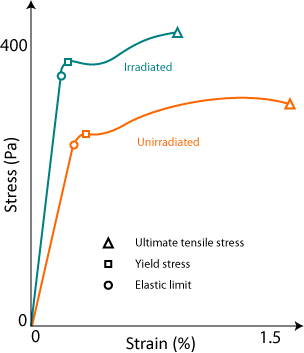Effects of Radiation Damage
The previously discussed changes in microstructure due to radiation damage affect the macroscopic, mechanical properties of the material. These effects happen for a variety of reasons, but are generally less noticeable at higher temperatures as the damage caused by radiation is constantly being annealed out: at higher temperatures vacancy and interstitial mobility are increased so they are removed from the lattice faster.
The following table gives an overview of the effects observed.
| Material Property | Effect of Radiation Damage |
| Yield strength | Increases on irradiation, along with a decrease in plastic flow range. |
| Ultimate tensile strength | This also increases on irradiation, but less than the yield strength. |
| Ductile-brittle transition temperature | This marks the transition between a material exhibiting ductile behaviour at higher temperatures and brittle behaviour at lower temperatures. It increases significantly on irradiation, which can present a problem when the reactor vessel cools on shut down when internal pressure within the reactor is still high, and so fracture can occur if this is not taken into account. |
| Young’s modulus | Small increase on irradiation. |
| Hardness | Increase. |
| High-temperature creep rate | Increase during irradiation. |
| Ductility | Decrease. |
| Stress-rupture strength | Decrease. |
| Density | Decrease as the material swells on irradiation. |
| Impact strength | Decrease. |
| Thermal conductivity | Decrease on irradiation since lattice disorder increases, thus increasing phonon scattering. |
| Electrical conductivity | Decrease for similar reasons to thermal conductivity. |
The following sketch shows the stress-strain curve for a typical steel and its different form after irradiation.
 |
| A stress-strain curve for a stainless steel irradiated or not. |

